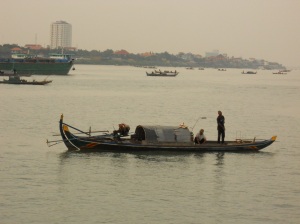By Lindsey Dietz, MBA Class of 2012
I recently traveled to Cambodia as part of my final capstone project for Portland State University’s MBA program. I was responsible for developing and delivering marketing curriculum for a group of social entrepreneurs from five different countries. The difficulty of this project was creating curriculum that could be applicable across multiple geographies, cultures and economic situations. This was compounded by the fact that each student had a different style of learning and educational background. You can learn more about my work and the reason for the trip here http://impactentrepreneurs.wordpress.com/author/lindseydietz/
I missed two weeks of our e-marketing class on this wonderful adventure including the discussion that covered chapter four of our book. The topics covered that week included global markets, the digital divide and emerging economies. The chapter highlighted Cambodia a few times. In order to understand Cambodia’s current developmental state it is important to know a little more about the history, specifically the last 40 years. Please note that this is unpleasant to read.
History: In 1975, the Communist Party of Kampuchea (CPK), commonly known as Khmer Rouge overthrew the Cambodian government and established control. At the time, most citizens didn’t even know the regime change took place. The Khmer Rouge held radical beliefs and wanted to transition the country into a rural, classless society in order to the end economic disparity and exploitation. In order to meet these goals they evacuated the cities and moved nearly two million people in to the countryside to begin farming and manual labor. Most people were taken without anything but the clothes on their back. Many people starved and died during the forced labor.
In order to establish a classless society the new government banned schooling, privet property, money, religion, free markets and anything that differentiated individuals. Public and private transpiration was abolished and all non-revolutionary entertainment was forbidden. Schools, government buildings and religious sights were turned into prisons, death camps or stables. Anyone that didn’t comply was considered a traitor and sent to one of the prisons where torture and death was often a result. About 300 mass graves are scattered around Cambodia where the government executed traitors. These areas called the “killing fields” are a reminder of the not so distant past.
From 1975 to 1979 when the Khmer Rouge party was overthrown nearly 30% of Cambodia’s population died from disease, starvation and the government. This is roughly between two and three million people. The surviving population was plagued by mental illness and severe post traumatic stress. In addition, the country was left with millions of mines that had been scattered by the Khmer Rouge party, and remnants from the war between Vietnamand the US. The rebuilding efforts will take generations. To learn more about the history and genocide trial for remaining Khmer Rouge party members please visit http://www.cambodiatribunal.org/history/khmer-rouge-history
Today: Some important statistics for digital marketing in Cambodia from the CIA World Factbook:
- Roughly 73% of the population is literate (2009)
- 358,800 telephone landlines. This is partially due to the danger of unearthing land mines.
- Cell phone use is about 8.1 million (roughly 60% of population in 2010) and growing. Cellular technology has allowed Cambodia to leapfrog technologies bypassing landlines.
- 5,452 internet hosts (2010)
- 78,500 Internet users (2009). Less than 1% of the population but growing due to cell phone use.
The history of the country plays a significant role in digital development. The impact of the Khmer Rouge regime significantly impaired the economic, educational and digital progress of the nation. Expats and international organizations from around the world have moved into Cambodia to help reestablish schools and facilities. Despite internet being available in the cities, most citizens don’t have enough education or money to use the services.
The digital divide is pronounced in Cambodia. I sat at a restaurant in Phnom filled with international aid workers from developed nations. Most of these expats were typing away on their laptops. When I looked out the window at the river, I could see anglers from a local village that use substance farming and money from the fish to survive. The economic division and digital divide is visible everywhere.
One of the organizations helping to close the gap is aptly the named Digital Divide Data (DDD). I was actually at the DDD office during my week of teaching. The organization aims to provide education and IT knowledge to talented disadvantaged youth in developing nations. They currently have facilities in Cambodia, Laos and Kenya. DDD is a social enterprise business that provides business process outsourcing (BPO) such as digitization services to local and international clients. They are a social enterprise because of the recruiting and hiring practices. DDD provides money for higher education to their beneficiaries while employing them to do digital services. DDD is one of the only IT services organizations in Cambodia and is successfully training a new generation of digital users.
How important do you think education is in the development of digital services?
Have you had any experiences with the digital divide at home or abroad? What were they?
What do you think of DDD’s efforts?



